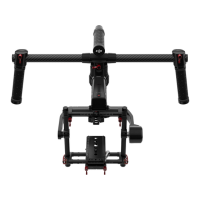Ronin-MX
User Manual
©
2016 DJI All Rights Reserved.
29
Balance Test: Select the checkbox to check the balance status of the roll and tilt axis.
Manual Adjustment: Enable Manual Adjustment to allow the pan and tilt axes to be
adjusted by hand when the Ronin-MX is turned on.
Calibrate System: Calibrate System is only used if you notice any kind of drift in any of the
axes. To calibrate the system, place the Ronin-MX on the tuning stand and make sure it is
completely steady.
Be sure the camera can rotate 90 degrees with the lens pointing straight down, without
any interference from video monitor wires. Then click the Calibrate System button and
let the process nish before picking up the Ronin-MX. Do not move the Ronin-MX during
calibration.
Auto Tune Stability: The Auto Tune Stability button allows for automatic adjustment of each
motor’s stiffness settings (as relayed from the sensors and interpreted by the Ronin-MX).
Default: Click here to restore all settings to the factory defaults.
2. Control
The Thumb Controller and the remote operator control sticks have a Deadband, Maximum
Speed, and Smoothing adjustment, all of which can be set independently.
Endpoint: Pan axis endpoints can be adjusted independently for left and right movement
when used with a Remote Controller or the Thumb Controller. Tilt axis endpoints can be
adjusted independently for up and down movement when used with a Remote Controller
or the Thumb Controller.
The pan and tilt endpoints can be tested. Ensure that the camera is unobstructed when
clicking the test buttons.
Controller Priority: If both input devices simultaneously send control signals to the gimbal,
the input from the selected controller will take priority and will control the device at that
given time.
Pan/Tilt Remote Speed Adjustment: Click to choose combined or independent settings.
Speed Toggle Presets: These presets will allow you to change the SmoothTrack speed

